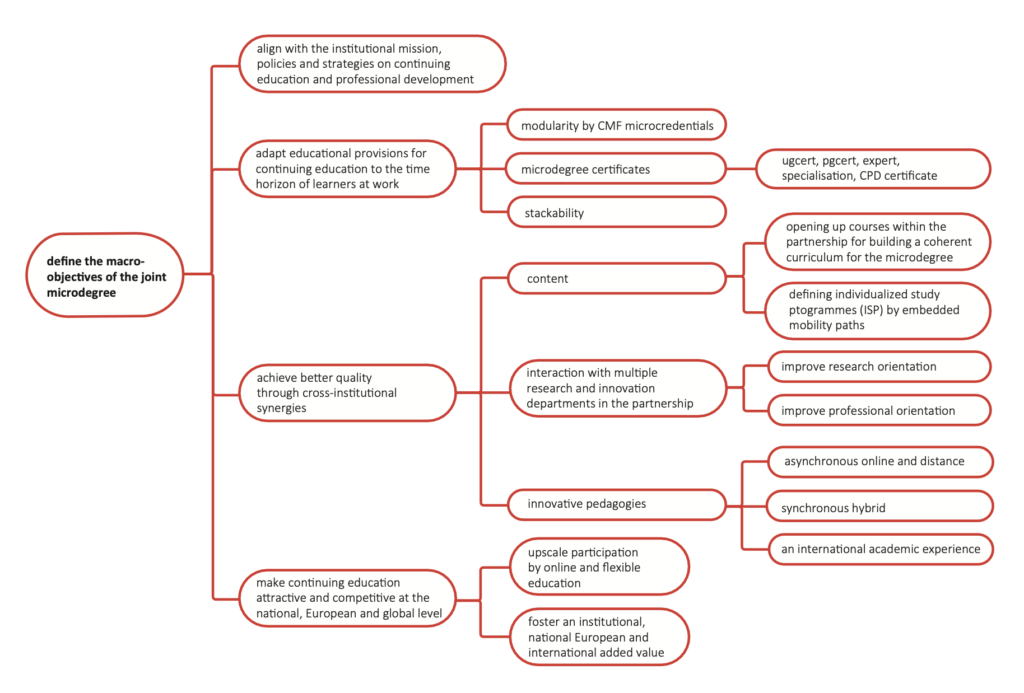
| The macro-objectives of a joint micro-credential programme should fit the mission of the university and frameworks for continuing education and professional development, which may include different aspects: |
| Align with the institutional mission, policies and strategies on continuing education and professional development; |
| Adapt educational provisions for continuing education and professional development to the time horizon of learners at work; |
| Achieve better quality through cross-institutional synergies; |
| Make continuing education attractive and competitive at the national, European and global level. |
Align with the institutional mission, policies and strategies for continuing education and professional development
European higher education is evolving into three areas of education: mainstream education, continuing education and open education (OER, MOOCs). In the perspective of the transformation agenda for higher education, universities are becoming more interwoven with the knowledge-intensive sectors of society, responding to the needs of the economy
and society as a whole.
Some leading universities have already developed comprehensive policies for continuing education and professional development in line with their mission. They have built a framework for continuing education and professional development, for example an extension school. They have developed an institutional qualification structure for awarding certificates for micro-credential programme qualifications. These programmes are closely linked to research and innovation and mainstream education in their institution.
Nevertheless, it remains a challenge for all universities to create facilities for adult learners.
Because of their mission, open and distance learning universities organize degree programmes for mainly adult learners. They have become aware of the need for micro-credential and short learning programmes and have started to organize this provision on a larger scale.
Adapt educational facilities for continuing education and professional development to the time horizon of learners at work
Universities are aware that continuing education and professional development must adapt to the time horizon of learners through new forms of education such as micro-credential and micro-degree programmes. These new provisions should be recognized as stackable modules for broader degree programmes.
This approach creates new opportunities for continuing education and professional development. It is now supported by the European Commission, which has proposed a Recommendation to the Council of Ministers to establish a framework for micro-credentials.
Thus, it becomes the new priority for national governments and higher education institutions. Frontrunner universities will help determine this development.
Achieve better quality through cross-institutional synergies
By organizing micro-credential programmes, universities achieve better quality through institutional synergies. They make their best content available within the partnership to respond to real-world needs in society. These programmes are also personalized by organizing individualized study plans and embedded mobility paths.
This collaboration builds on and promotes close interaction with research and innovation departments in the partnership. Through these synergies, they enhance both the research and professional orientation of micro-credential programmes.
The programmes are also an asset for pedagogical innovation that enables institutions to reach learners across Europe, create an international experience for them and apply new ways of delivery. using methods of blended, synchronous hybrid and online distance learning.
Make continuing education attractive and competitive at national, European and global level
Leading universities can offer micro-credential programmes to make continuing education more attractive and competitive at national, European and global levels. Digital delivery methods enable them to scale up participation in their programmes and improve quality in content and pedagogy.
In this way they provide institutional, national, European and international added value.
next chapter: Build the partnership
previous chapter: Align with European and national developments
back to overview: Models and guidelines for the design and development
of a joint micro-credential programme in higher education
